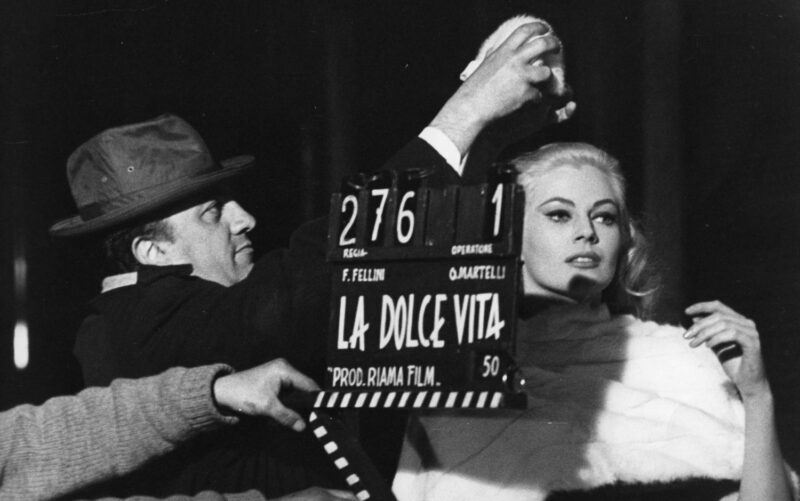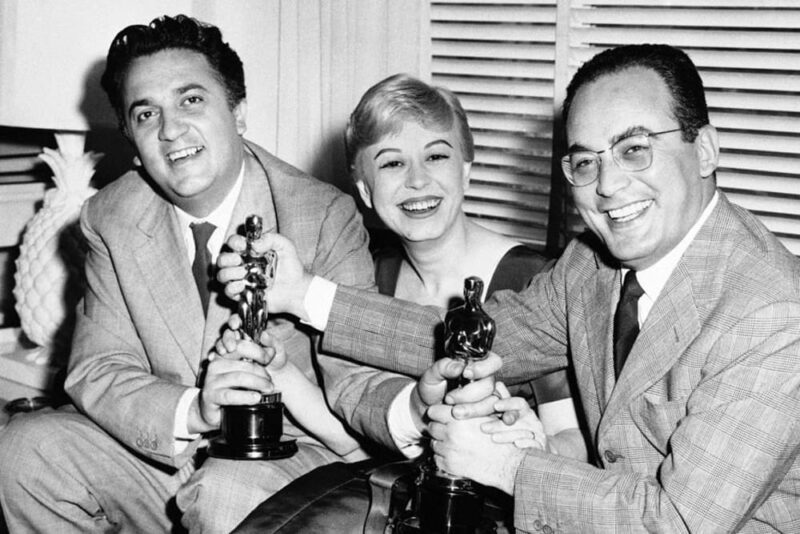Born in Rimini on 20 January 1920, Federico Fellini is the author of films that became world cinema classics. Just think about “La Dolce Vita, Otto e Mezzo, Amarcord, La Strada, Le Notti di Cabiria” to evoke suggestions made of enchantments, which are intertwined with his life. After four Oscars for masterpieces that entered “forever”, on 29 March 1993, he received the fifth career that he retired in Los Angeles and dedicated entirely to his lifelong companion and muse: Giulia Masina, renamed Giulietta by himself. Nobody will ever forget the speech of thanks in front of the Academy and the tears full of the love of his wife, who shared essential pages of world cinema with him.

They met in the EIAR studios in 1942 during the recording of an episode of Cico and Pallina. He was one of the authors, and they never left each other again, between alleged betrayals of him, film sets and a son who unfortunately died later, only 12 days after birth. Years later, Giulietta said: “Not having had children made us become the son and daughter of the other, so destiny willed”. Both are buried in Rimini next to their unborn child. Their characters could not have been more different, but they complemented each other, and their differences kept them united until their death a few months later. He left this life exactly one day after their 50th wedding anniversary; she followed him a few months later.

Of all the characters played by Juliet in her long career, the most exciting remains that of Gelsomina in La Strada, for which her husband refused any other candidacy. The sweet clown who accompanies the gipsy Zampanò played by Antony Quinn. This interpretation earned Juliet the nickname of Chaplin in the feminine, and it seems that the silent master himself said: “She is the actress I admire most”. Charlie Chaplin also made a comic of the opera. After leaving Rimini, the filmmaker transformed the famous “Teatro 5 of Cinecittà” into an ideal setting for almost all of his films, dedicating himself to a visual narrative that oscillates between lost youth and the autobiography of adult life, often with an alter-ego of exception: Marcello Mastroianni to whom the director will give the nickname of Snaporaz.
The actor from Fontana Liri and the director from Rimini, together, will give life to many iconic scenes that have defined Fellini’s cinema as that: “Marcello, come here” as luxurious as the famous actress Anita Ekberg. The latter plunges into the Trevi Fountain. as if it were a bathtub in La dolce vita, where stories that penetrate the present atmospheres merge with the memories of the director’s hometown. Rimini returns several times in his films, so much so that he said: “Rimini is a confused, fearful, tender mess, with this great breath, this void open to the sea. Their nostalgia becomes more explicit, especially at sea in winter, the white crests, the great wind, as I saw it the first time “.

The suggestions drawn from his homeland will always accompany him, like fairy tales with open eyes that condense and is immortalized in Amarcord, where the character of La Gradisca becomes a legend. Despite the explicit reference to the memories of his childhood, Fellini never suffered from nostalgia. On the contrary, he managed to find the Emilian city’s characteristics even in Rome: “I had found Rimini in Rome. Rimini to Ostia and Rome. In Ostia I shot I Vitelloni because it is an invented Rimini, it is more Rimini than the real Rimini”. It was equipped with a dreamlike style connoted with the term magic realism and, later, “fantasy realism”. Federico Fellini, also in the memories of his great friend Ettore Scola, leads us into a world that has not lost the naivety and purity and still appears fresh and uncontaminated today.

Where among Rhinos sick with the sadness of love, as in the film La nave V.A., with the photography by Giuseppe Rotunno and the scenography by Dante Ferretti, it also happens to meet one of the greatest screenwriters: Tonino Guerra and sung operas by the poet Andrea Zanzotto in addition to the character of Princess Lherimia interpreted by the German ballerina and choreographer Pina Bausch. But Fellini’s cinema is all a memory of great names. Each of his works is a pretext to remember great composers, great directors of photography or cinematographers, great screenwriters, great producers, and great distributors of great interviews.
The celebrations of the 100th anniversary of Federico Fellini birth should be celebrated in 2020 but has been postponed to 2021. To the 100th anniversary of the birth of his muse and companion who, despite the beautiful actresses who attended the director’s sets, was never replaced, the Cultural Association Center for Studies of Psychology of Art and Expressive Psychotherapies A.P.S. by an idea by Paola Dei, with the artists of the A.L.I. Association Independent Free Artists, he wanted to dedicate a tribute that would represent him in the round, evoking his suggestions, the music, the friendship with George Simenon, the interviews with Oriana Fallaci, the unforgettable moments of the films of which Tonino was the screenwriter in many of the War.

The video that has obtained the patronage of the Fellini 100 Committee uses the music granted by Maestro Vince Tempera taken from the official concert of Fellini’s 100 anniversary, the works of the artists of the A.L.I. and the voices of actors and actresses who wanted to leave a mark by recreating Fellini’s atmospheres. This word had become so common that the director himself said: “When I grew up, I had always dreamed of making the adjective. I am flattered. Americans mean by “Fellini” I can imagine: opulent, extravagant, dreamlike, bizarre, neurotic, shitty “.
The video is edited by Eros Regoli and Sara Torrac, the quotes that evoke memories are by Valerio Caprara for Aldo Tassone, author of one of the most complete texts dedicated to Fellini, Franco Mariotti, the voices are by: Daniela Benori, Cloris Brosca, Violetta Chiarini, maria Caterina Dei, Paola Dei, Lucia Donati, Martina Guideri, Laurentina Guidotti, Elisa Mariotti, Simone Migliorini, Adriana Migliorini, Maria Rosaria Omaggio, Mariano Rigillo, Anna teresa Rossini, Framcesca Stajano Sasson. As you can see with a simple click at the link https://fellini100.beniculturali.it/news/detail/118 you can admire the video that aims to spread film culture through the life and works of the great master and his muse.

The historical moment crossed, the relationships that characterized the great director’s life, the interviews, the friendships, the native places and the places travelled, the suggestions of the Terme di Chianciano and Montecatini in Tuscany. The magical characters who manage to transform themselves into emotional living make us partakers of an unrepeatable trademark that allows us to dream and experience unique and unforgettable suggestions. The video also intends to be an educational tool for children and adolescents to stimulate the deepening of culture and increase the audiovisual medium’s knowledge.
Article edit by Paola Dei

